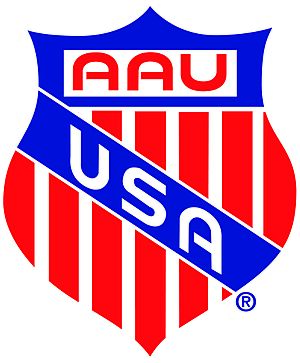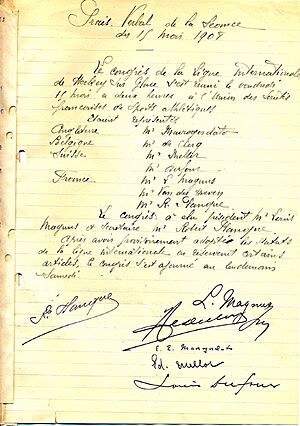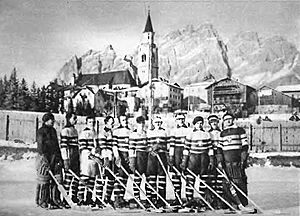History of the International Ice Hockey Federation facts for kids
The story of the International Ice Hockey Federation (IIHF) is over a hundred years old! It's all about how countries learned to work together in ice hockey. The IIHF has done amazing things, like making sure everyone plays by the same rules and creating exciting tournaments.
Contents
How the IIHF Started: 1908–1913
The International Ice Hockey Federation began on May 15, 1908. It was founded in Paris, France. Back then, it was called the Ligue Internationale de Hockey sur Glace (LIHG).
Representatives from five countries started it:
- Belgium
- Bohemia (now part of the Czech Republic)
- France
- Great Britain
- Switzerland
Louis Magnus from France was the first president of the LIHG.
Early Meetings and Rules
The second meeting happened in January 1909 in Chamonix, France. Here, they made important decisions about playing rules. They also agreed to have a European Championship every year, starting in 1910. Germany joined the LIHG in September 1909.
The first European Championship was held in 1910. Great Britain won this first big tournament. In 1911, Russia joined the LIHG. That same year, the LIHG decided to use the Canadian rules for ice hockey.
New Members and Changes
In 1912, the LIHG welcomed Austria, Sweden, and Luxembourg. Henri van den Bulcke became the new president. The first LIHG Championship was also held that year. This tournament happened every year until 1914.
At the 1913 meeting, the LIHG also organized the first European Bandy Championship. Bandy is a sport similar to ice hockey, played on ice with a ball.
Growing Through Challenges: 1914–1945
In 1914, Louis Magnus briefly became president again. But he resigned quickly because others didn't agree with his plans. Henri van den Bulcke was then re-elected president. He stayed in charge until 1920.
World War I and New Beginnings
World War I stopped all LIHG activities between 1914 and 1920. After the war, Austria and Germany were removed from the federation. Bohemia's membership changed to the new country of Czechoslovakia.
Ice hockey became part of the Olympics for the first time in 1920. Canada and the United States joined the international hockey scene. They were much better than the European teams. Canada won gold, and the U.S. won silver. Both countries became LIHG members in April 1920.
New Leadership and Tournaments
Paul Loicq was elected president in 1922. In 1923, the LIHG decided that the 1924 Olympic Games would also count as the World Championship. They also planned a separate European Championship. Romania, Spain, and Italy joined the LIHG that year.
Austria was allowed back into the LIHG in 1924. Sweden left for a short time because Germany was not allowed back in yet. Sweden returned in 1926 after Germany was re-admitted.
The 1928 Winter Olympics had a record 11 countries playing. Canada won its third gold medal.
In 1929, the LIHG decided to have a separate World Championship starting in 1930. The first one began in Chamonix, France. But the ice melted, so it finished in Vienna and Berlin. Canada was so strong that they went straight to the final game. They easily beat Germany to win the gold. Japan joined the LIHG and sent a team of medical students to the tournament.
The 1932 Winter Olympics had only four teams because of a worldwide money crisis. Canada won its fourth Olympic gold medal. The 1932 European Championship was the last one held on its own. Sweden won its third European title.
Milestones and More Members
The LIHG celebrated its 25th birthday in 1933. By then, they had held many championships. The 1933 World Championship was special. It was the first time Canada did not win a World Championship or Olympic tournament. The United States beat them 2–1 in overtime.
More countries joined the LIHG in the 1930s. These included the Netherlands, Norway, Latvia, Estonia, Lithuania, and South Africa.
The 1936 Winter Olympics had a new record of 15 teams. Great Britain won its first and only Olympic gold medal. Most of their players had grown up in Canada.
World War II stopped all LIHG events from 1940 to 1946. During the war, the Canadian and U.S. hockey groups formed their own International Ice Hockey Association.
Rebuilding and Renaming: 1946–1956
The first LIHG meeting after the war was in April 1946. Germany and Japan were removed from the federation. The memberships of Lithuania, Latvia, and Estonia were canceled because they were taken over by the Soviet Union. Austria got its membership back. Denmark joined as a new member.
Post-War Hockey and New Leadership
The first World Championship after the war was in Prague in February 1947. Czechoslovakia won the gold medal. Paul Loicq, who had been president for 25 years, stepped down. Fritz Kraatz took his place.
In 1947, the LIHG joined with the International Ice Hockey Association. They agreed that the presidency would switch between North America and Europe every three years.

The 1948 Winter Olympics had some problems. Two American groups both sent teams. The International Olympic Committee (IOC) first said neither team could play. The LIHG threatened to boycott the whole hockey tournament. In the end, one U.S. team played, but they were not included in the Olympic rankings.
W. G. Hardy became president in 1948. He was followed by Fritz Kraatz again. During this time, Germany and Japan were allowed back in. The Soviet Union also joined and won its first World Championship in 1954.
A New Name
Walter A. Brown became president in 1954. At this time, the federation changed its name to English. It became the International Ice Hockey Federation (IIHF). In 1956, East Germany became the IIHF's 25th member.
In its early years, the LIHG also managed bandy. But bandy became less popular in many countries. In 1955, a separate group called the International Bandy Federation was created for that sport.
Growth and Challenges: 1957–1974
The Hungarian Revolution of 1956 caused some countries to boycott the 1957 World Championships in Moscow. Canada and the United States led this boycott.
New Members and Political Tensions
The IIHF welcomed new members between 1960 and 1963. These included Bulgaria, North Korea, China, and South Korea.
At the 1961 World Championship, the West German team refused to play against East Germany. They didn't want to salute the East German flag if East Germany won. East Germany was given the win. Two years later, East German players turned their backs on the West German flag after losing to them.
The 1962 World Championship in the U.S. was boycotted by the Soviet Union and Czechoslovakia. Other Eastern Bloc countries also boycotted. This was partly because of the 1957 boycott and because the U.S. would not accept East German passports.
The IIHF started having different levels of competition (Pools A, B, and C) every year in 1961. Teams could move up or down between these levels.
New Competitions
For the 1965–66 season, the IIHF created the European Cup. This tournament was for the best club teams in Europe. It was inspired by the European Cup in soccer. In 1968, the IIHF started the European U19 Championship for younger players. The age limit was later changed to 18.
The IIHF had three different presidents during this period: Bunny Ahearne, Robert Lebel, and William Thayer Tutt.
Modern Era: 1975–1989
In 1975, Günther Sabetzki became president of the IIHF. He stayed in office for almost 20 years. This time is seen as a very successful period for international ice hockey.
Canada Returns
Sabetzki's biggest success was getting Canada to return to the World Championships and Olympic Games. Canada had boycotted these tournaments from 1970 to 1976. This was because the IIHF would not let them use professional players from NHL teams.
President Sabetzki found a way to make everyone happy. Professional players whose teams were out of the playoffs could now play. In return, Canada agreed to join the World Championships again. They also agreed not to host any World Championships for a while. The creation of the Canada Cup (a tournament organized by the NHL in Canada) was also part of this new agreement.
Walter Wasservogel became the first full-time general secretary of the IIHF in 1978.
Junior and Women's Hockey
The first official World Junior Championships for players under 20 was held in 1977. This tournament became very popular, especially in Canada. A famous event was the "Punch-up in Piestany" in 1987. This was a big fight between Canada and the Soviet Union teams. Both teams were kicked out of the tournament.
Two new tournaments were started in the 1980s:
- The Asian Oceanic U18 Championship (1984)
- The first Women's European Championship (1989)
Global Expansion: Since 1990
The IIHF continued to grow a lot in the 1980s and 1990s. This was due to political changes and hockey becoming more popular worldwide.
New Countries Join
When the Soviet Union broke apart, its membership went to Russia. Four new countries from the former Soviet Union joined: Azerbaijan, Belarus, Kazakhstan, and Ukraine. Also, Estonia, Latvia, and Lithuania rejoined. They had been members in the 1930s but were removed when the Soviet Union took them over.
The breakup of Yugoslavia also brought new members. Croatia and Slovenia joined. The old Yugoslavia's membership went to FR Yugoslavia (which later became Serbia and Montenegro, and then Serbia and Montenegro). When Czechoslovakia split, its membership went to the Czech Republic, and Slovakia joined as a new member.
Because of all these new members, the top-level World Championship tournament got bigger. It went from 8 teams to 12 in 1992, and then to 16 in 1998.
Many other countries joined the IIHF in the 1980s and 1990s, including Chinese Taipei, Hong Kong, Brazil, Mexico, Greece, India, Thailand, Israel, Turkey, Iceland, Ireland, Singapore, Argentina, Armenia, Mongolia, and Portugal.
New Leadership and More Tournaments
In June 1994, René Fasel became the President of the IIHF. He has served many terms. In 1995, he helped make an agreement for NHL players to play in the 1998 Winter Olympics in Nagano, Japan.
The first Women's World Championship was held in 1990 in Ottawa, Canada.
Many other tournaments have been created by the IIHF since the 1990s:
- IIHF World U18 Championships (1999)
- Continental Cup (1997)
- European Hockey League (1996–2000)
- Euro Ice Hockey Challenge (2001)
- European Women's Champions Cup (2004)
- World Women's U18 Championships (2008)
- Challenge Cup of Asia (2008)
100th Anniversary and Recent Events
The IIHF celebrated its 100th birthday in 2008. As part of the celebration, the 2008 World Championship was held in Canada for the first time. An IIHF Centennial All-Star Team was also chosen by votes.
The number of IIHF members keeps growing. Since 2000, countries like Chile, Bosnia and Herzegovina, United Arab Emirates, Macau, Malaysia, Georgia, Morocco, Kyrgyzstan, Jamaica, Qatar, Oman, Turkmenistan, Indonesia, Nepal, Philippines, Algeria, Colombia, Iran, Lebanon, and Uzbekistan have joined.
In 2017, Namibia left the IIHF because there wasn't enough ice hockey activity in the country.
The IIHF faced challenges regarding where to hold tournaments. For example, the 2021 Men's Ice Hockey World Championships was planned for Belarus. But due to safety and security concerns, and the COVID-19 pandemic, the IIHF decided to hold the tournament only in Riga, Latvia.
In May 2021, there was an incident involving a plane landing in Minsk. As a result, Latvian officials changed the Belarusian state flag at the World Championship display in Riga. The IIHF stated it is an "apolitical sports organization" and asked for its symbols to be removed or the flag restored.
On February 28, 2022, the IIHF suspended Russia and Belarus from international play. This decision was made because of the 2022 Russian invasion of Ukraine.





